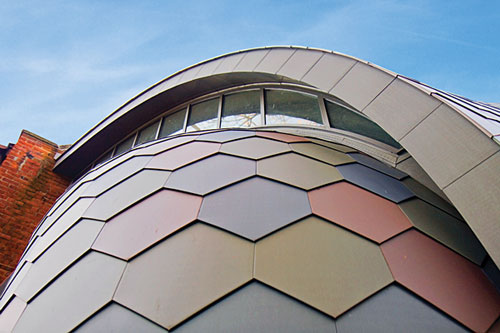Zinc Roofing and Wall Systems
When zinc is used as a building material, it is actually fabricated as an alloy. Typically, it is 99.995 percent pure zinc, produced by an electrolytic process that introduces very controlled trace quantities of copper and titanium. The copper helps with mechanical resistance, making zinc easier to work with. The titanium is added to alleviate the tendency of material creep. Historically, it was observed that a sloped pure zinc roof on a building would become much thicker at the bottom of the roof than at the top in as little as five years. The zinc would literally “creep” down the roof over time, prompting the addition of titanium to overcome that problem.
The manufacturing of zinc into building products has been refined over the past 100 years or more to the point where it is quite efficiently and sustainably done. Once the metals are mined, they go through a casting process at a mill that obviously requires heat to form the metal into usable portions for processing. The environmental air emissions produced from zinc processing at these plants are minimized due in part to the use of up-to-date equipment and emission abatement processes. But compared to other metals, it is worth noting that zinc requires significantly less energy to process due to its relatively lower melting point of 786 °F compared to other metals like aluminum at 1,120 °F, copper at 1,983 °F, and steel at 2,372 °F. Following this process, the zinc is then rolled, cooled and transformed into large primary coils which are further rolled and cut into smaller, saleable coils to be formed into specific building products.
 |
Photo courtesy of VM Zinc Zinc forms a natural gray protective patina and can be pre-weathered in a variety of colors. |
ASTM B6-09 is the “Standard Specification for Zinc” as a metal and covers zinc processing from ore by a process of distillation or by electrolysis in five grades: LME grade (related to the London Metal Exchange standards), special high grade, high grade, intermediate grade, and prime western grade. Under this standard, the zinc metal is tested to conform to chemical composition requirements free of any surface corrosion and adhering foreign matter. The most common, but separate building-related standard for products then manufactured out of zinc metal is ASTM B69-09 “Standard Specification for Rolled Zinc.” This standard covers Type I coils or sheets cut from strip rolled zinc, and Type II zinc plates such as boiler and hull plates produced by any rolling method. This accepted standard dictates the dimensional tolerances for thickness, width, length, saber and flatness. It also dictates the quantity of the trace elements that can be contained in the product.
While two-thirds of the zinc manufactured worldwide is used for flashings and rainwater goods, zinc roofing and wall cladding have become attention grabbing design elements. Products are available in a full range of applications from low-sloped roofing, high-sloped decorative roofing, ornamental features such as eyebrows and dormers, wall panels, rain screens, and sun shading devices. As an exposed and visible part of the building envelope, it is distinguished by its beautiful patina characteristics that many building professionals are starting to understand and seek. When rolled zinc first comes out of the mill, it is shiny like mill-bright aluminum. As the material is exposed to air, humidity, and pollution, it weathers, naturally creating a gray-colored patina that develops over time, much the same way bright mill copper develops a brown and then green patina over time. With zinc, this natural patina is a layer of zinc hydroxy-carbonate that typically takes 2 to 5 years to develop fully depending on environmental factors such as air quality and humidity. So, in areas with a higher concentration of CO2, the patina appears more quickly while zinc used in protected interior applications may rarely, if ever, develop a patina. Once the patina develops, the zinc has a uniform and consistent color of gray for its lifespan. However, the patina layer also has unique characteristics that contribute to its sustainability. The patina layer is compact and insoluble to rainwater which thereafter controls the rate of corrosion. This patina is said to be a self-healing protection for the zinc. If it becomes scratched or is removed mechanically, it will naturally redevelop from continued exposure to rainwater and carbon dioxide. The scratch would appear first as a shiny area but would then appear to actually “heal” itself as the patina reforms.
Zinc manufacturers also offer pre-patina materials, sometimes called pre-weathered, with a gray look that is very true to the natural soft gray patina. To achieve this look, the shiny or natural zinc coils are run through an acidic bath giving the material a weathered appearance. The longer the period of time they are in the bath, the darker the resulting color. Manufacturers also offer factory-applied transparent organic coatings that include subtle blues, reds and greens. Over time these colored and darker shaded materials will still develop the natural gray zinc patina eventually. The length of time for this to happen, however, still varies with air quality but typically these colors will last up to 30 years before gradually changing to the natural gray.









